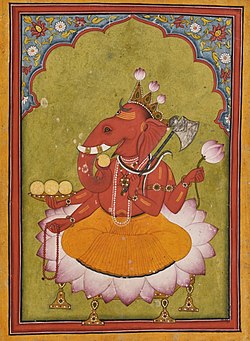गनेद्यः: Difference between revisions
Content deleted Content added
Eukesh (खँल्हाबल्हा | योगदान) No edit summary |
|||
| Line १: | Line १: | ||
{{Infobox Hindu deity| <!-- Wikipedia: WikiProject Hindu mythology --> |
|||
| Name = गणेद्यः |
|||
| Image = Ganesha Basohli miniature circa 1730 Dubost p73.jpg |
|||
| Caption = [[Basohli Painting|Basohli]] miniature, circa 1730. [[National Museum, New Delhi|National Museum]], [[New Delhi]], [[India]].<ref>"Ganesha getting ready to throw his lotus. Basohli miniature, circa 1730. National Museum, New Delhi. In the {{IAST|Mudgalapurāṇa}} (VII, 70), in order to kill the demon of egotism ({{IAST|Mamāsura}}) who had attacked him, {{IAST|Gaṇeśa Vighnarāja}} throws his lotus at him. Unable to bear the fragrance of the divine flower, the demon surrenders to {{IAST|Gaṇeśha}}. " For quotation of description of the work, see: Martin-Dubost (1997), p. 73.</ref> |
|||
| alt = Attired in an orange dhoti, an elephant-headed man sits on a large lotus. His body is red in colour and he wears various golden necklaces and bracelets and a snake around his neck. On the three points of his crown, budding lotuses have been fixed. He holds in his two right hands the rosary (lower hand) and a cup filled with three modakas (round yellow sweets), a fourth modaka held by the curving trunk is just about to be tasted. In his two left hands, he holds a lotus above and an axe below, with its handle leaning against his shoulder. |
|||
| Devanagari = गणेश |
|||
| Sanskrit_script = गणेश |
|||
<!-- | Tamil_script = பிள்ளையார் |
|||
| Tamil_Transliteration = Pillaiyar --> |
|||
<!-- | Telugu_script = వినాయకుడు |
|||
| Telugu_Transliteration = Vinayakudu --> |
|||
| Affiliation = [[द्यः]] |
|||
| Mantra = श्री गणेशाय नमः, ॐ गं गणपतये नमः |
|||
| Weapon = परशु ([[पाः]],<ref name="parasu"> |
|||
* For the paraśu (axe) as a weapon of Ganesha, see: Jansen, p. 40. |
|||
* For the ''{{IAST|paraśu}}'' as an attribute of Ganesha, see: Nagar, Appendix I.</ref> <br /> {{IAST|Pāśa}} (Lasso),<ref name="pasa"> |
|||
* For the snare as a weapon of Ganesha, see: Jansen, p. 46. |
|||
* For the ''{{IAST|pāśa}}'' as weapon of Ganesha in various forms, see: Nagar, Appendix I.</ref> <br /> [[Ankus|{{IAST|Aṅkuśa}}]] (Hook)<ref name="ankus"> |
|||
* For the elephant hook as a weapon of Ganesha, see: Jansen. p. 46. |
|||
* For the {{IAST|aṅkuśa}} as an attribute of Ganesha, see: Nagar, Appendix I.</ref> |
|||
| Consort = [[Buddhi]] (wisdom), <br /> Riddhi (prosperity), <br /> [[Siddhi]] (attainment) <br /> or sometimes, none |
|||
| Mount = [[Mouse]] or [[Rat]] |
|||
}} |
|||
'''गणेद्यः''' [[हिन्दू धर्म]] कथं छम्ह द्यः ख। थ्व द्यःयात विघ्न नाशक द्यःया कथं हनिगु या। थ्व द्यःयात सकल द्यःतेत पुज्याये स्वया न्ह्यः पुज्याइगु या। वसपोलयात महाद्यः व पार्वतीया काय्या रुपय् वर्णन यानतःगु दु। वसपोलं याकनं च्वयेफैगु धका वर्णन यानातःगु दु। बाखँ कथं महाभारत व्यासं वय्कःयागु ग्वहालिं च्वयादीगु ख। वय्कःया छ्यँ किसिया दूगु व बाहन धाःसा छुं ख। |
'''गणेद्यः''' [[हिन्दू धर्म]] कथं छम्ह द्यः ख। थ्व द्यःयात विघ्न नाशक द्यःया कथं हनिगु या। थ्व द्यःयात सकल द्यःतेत पुज्याये स्वया न्ह्यः पुज्याइगु या। वसपोलयात महाद्यः व पार्वतीया काय्या रुपय् वर्णन यानतःगु दु। वसपोलं याकनं च्वयेफैगु धका वर्णन यानातःगु दु। बाखँ कथं महाभारत व्यासं वय्कःयागु ग्वहालिं च्वयादीगु ख। वय्कःया छ्यँ किसिया दूगु व बाहन धाःसा छुं ख। |
||
== Gallery == |
|||
== किपापुचः == |
|||
Gallery of free to use images |
Gallery of free to use images |
||
<Gallery> |
<Gallery> |
||
| Line २५: | Line ५२: | ||
File:Vighnaharta.JPG| |
File:Vighnaharta.JPG| |
||
</Gallery> |
</Gallery> |
||
==लिधंसा== |
|||
{{लिधंसा|}} |
|||
[[पुचः:हिन्दू धर्म]] |
[[पुचः:हिन्दू धर्म]] |
||
१८:४३, १४ ज्यानुवरी २०१३तक्कया संस्करण
| गणेद्यः | |
|---|---|
 | |
| देवनागरी | गणेश |
| स्वापू | द्यः |
| मन्त्र | श्री गणेशाय नमः, ॐ गं गणपतये नमः |
| ल्वाभः |
परशु (पाः,[२] Pāśa (Lasso),[३] Aṅkuśa (Hook)[४] |
| Consort |
Buddhi (wisdom), Riddhi (prosperity), Siddhi (attainment) or sometimes, none |
| वाहन | Mouse or Rat |
गणेद्यः हिन्दू धर्म कथं छम्ह द्यः ख। थ्व द्यःयात विघ्न नाशक द्यःया कथं हनिगु या। थ्व द्यःयात सकल द्यःतेत पुज्याये स्वया न्ह्यः पुज्याइगु या। वसपोलयात महाद्यः व पार्वतीया काय्या रुपय् वर्णन यानतःगु दु। वसपोलं याकनं च्वयेफैगु धका वर्णन यानातःगु दु। बाखँ कथं महाभारत व्यासं वय्कःयागु ग्वहालिं च्वयादीगु ख। वय्कःया छ्यँ किसिया दूगु व बाहन धाःसा छुं ख।
किपापुचः
Gallery of free to use images
लिधंसा
- ↑ "Ganesha getting ready to throw his lotus. Basohli miniature, circa 1730. National Museum, New Delhi. In the Mudgalapurāṇa (VII, 70), in order to kill the demon of egotism (Mamāsura) who had attacked him, Gaṇeśa Vighnarāja throws his lotus at him. Unable to bear the fragrance of the divine flower, the demon surrenders to Gaṇeśha. " For quotation of description of the work, see: Martin-Dubost (1997), p. 73.
- ↑
- For the paraśu (axe) as a weapon of Ganesha, see: Jansen, p. 40.
- For the paraśu as an attribute of Ganesha, see: Nagar, Appendix I.
- ↑
- For the snare as a weapon of Ganesha, see: Jansen, p. 46.
- For the pāśa as weapon of Ganesha in various forms, see: Nagar, Appendix I.
- ↑
- For the elephant hook as a weapon of Ganesha, see: Jansen. p. 46.
- For the aṅkuśa as an attribute of Ganesha, see: Nagar, Appendix I.




















